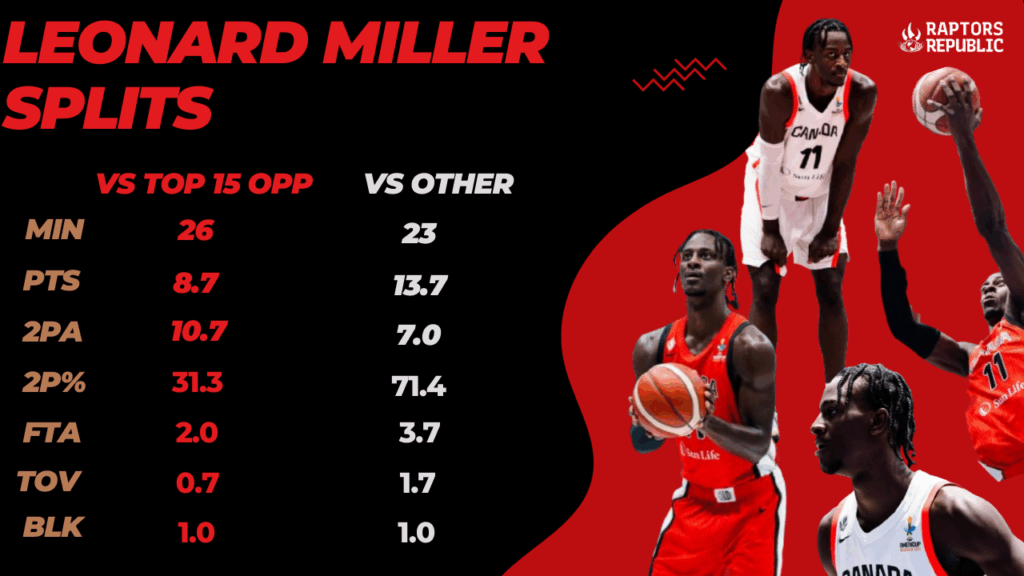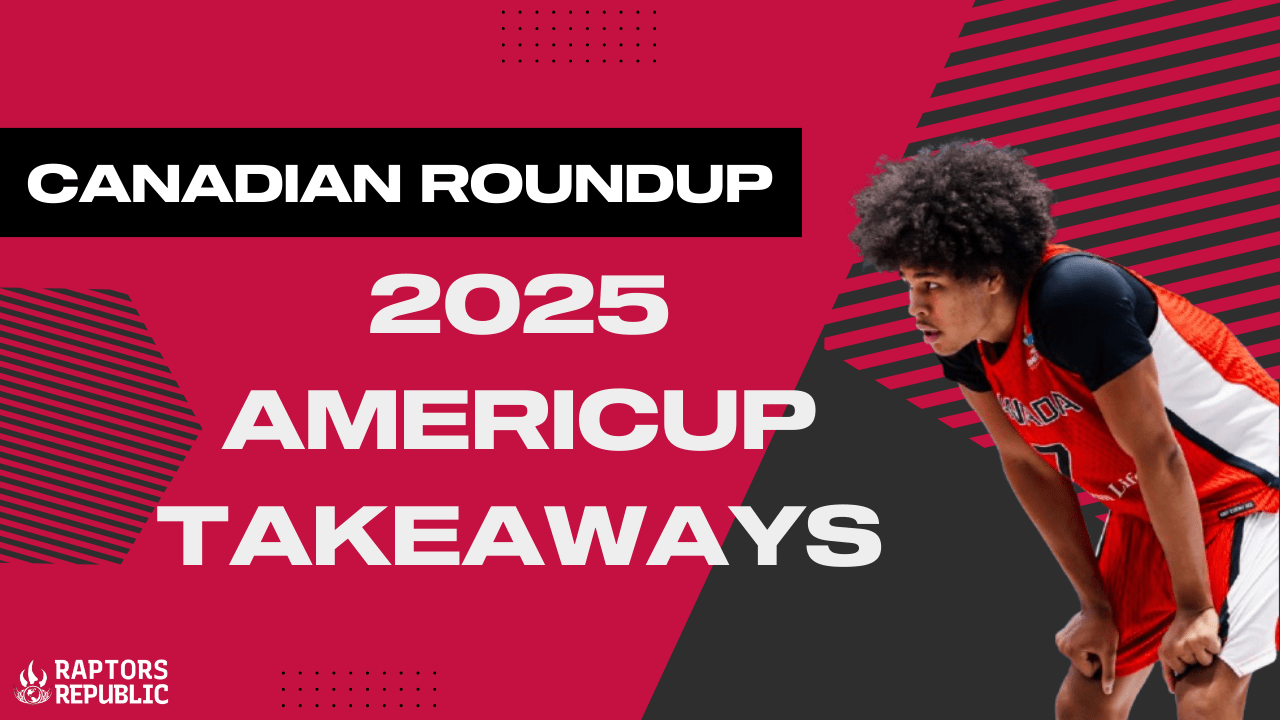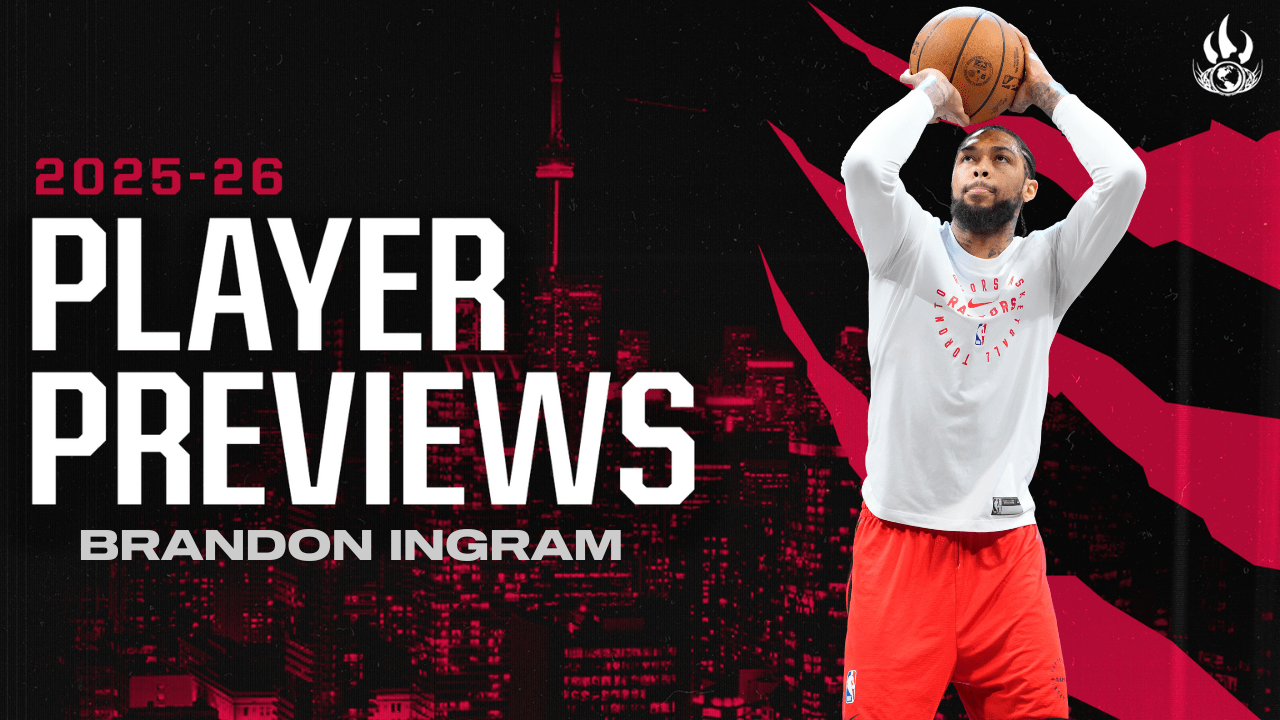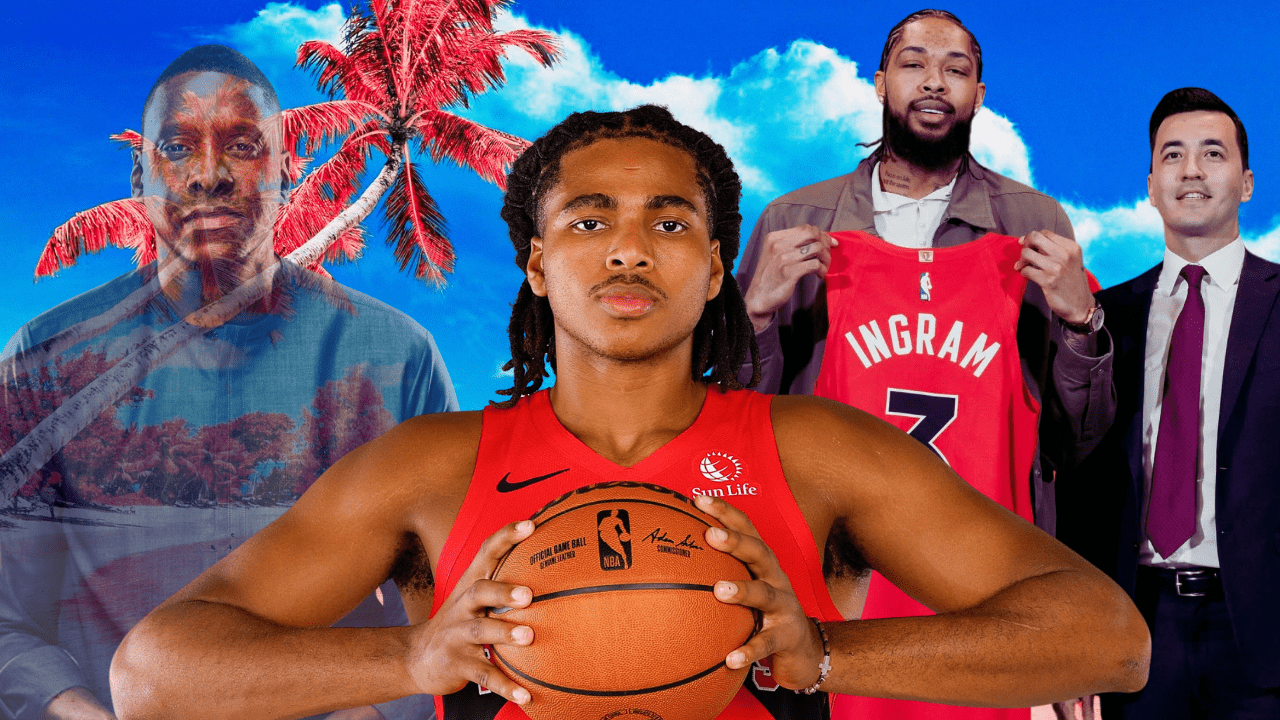After a strong 4-0 start to the 2025 AmeriCup, Team Canada limped to the finish line, finishing fourth for the second straight time and returned home once again without a medal. It’s a disappointing result, and even more so when considering how the SMNT lost their final two games. Rather than lose two close thrillers, Canada was dominated for nearly all 80 minutes, trailing by as much as 25 against Argentina in the semifinals and 17 to the USA in the Bronze medal game. Canada never had a real shot at winning either game and that stings considering they were the top seed entering the knockout stages. A good mix of talent, a stellar group stage performance and a favourable bracket (with other contenders looking vulnerable), it seemed the stars were aligning for the SMNT’s first AmeriCup medal since 2015. In the end, it was Canada Basketball who were more vulnerable than I imagined.
I’ve seen some chatter online about Canada Basketball being perennial underachievers and I think the dialogue, after another disappointing loss, is an important one to have so I’ll share my two cents. Was this fourth-place finish at the 2025 AmeriCup a disappointment? Undoubtedly, yes. Was I disappointed in the SMNT’s showing at the 2024 Paris Olympics. Also, yes as I have written previously. But I think where I differ from those calling for changes in Canada Basketball’s leadership (on the Men’s side) is an appreciation for the process, which has been slowly trending in the right direction since the last Olympic cycle, and realistic expectations. Re: the process, I’ll refer to a passage from a piece I wrote in October of 2024.
And let me be clear, while I do view the end result of the 2024 Olympics as a failure, the work that the SMNT has done in the years leading up to Paris (i.e. the process) has laid a strong foundation for the future of the program. The tireless and unwavering dedication to building continuity from GM Rowan Barrett, whether it’s through demanding multi-year commitments from the “Summer Core” or through the coaching staff establishing consistent offensive and defensive principles across competitions, has been immensely beneficial in stabilizing the program. There’s been a concerted effort to invest more money to support the high-performance teams, led by CEO Mike Bartlett. Canada’s focus on youth development continues through programs like the Junior Academy, Junior Team ID camps, annual U15 and U17 National Championship tournaments and events like GLOBL JAM.
Canadian Roundup: European Season Preview
On the point of realistic expectations, I think there’s been a false sense of belief within Canada when it comes to our status as a “basketball powerhouse” on the international stage. Canada Basketball (the “underachievers”) doesn’t have the track record performance-wise as a program to truly garner a “powerhouse” title. The SMNT has never won a Gold medal at the Summer Olympics, FIBA World Cup or FIBA AmeriCup, and have medaled just twice (winning Bronze both times) in the last decade. Lack of performance aside, others might point to the explosion of talent in the Men’s program player pool since the early 2010’s as indication of Canada’s “powerhouse” status. Canada’s “golden generation” and having the second most NBA players behind the USA are narratives that are parroted again and again each NBA season, painting Canada as the second best basketball nation in the world. While there’s no doubt Canada’s player pool is expanding at a rapid rate, to me though, a more telling metric of basketball powerhouse status would be looking at a breakdown of NBA and EuroLeague players by country. Based on 2024 rosters for the NBA and EuroLeague, Canada’s status in the basketball world looks a little more sensible:
| Total | NBA | EuroLeague | |
| USA | 537 | 453 | 84 |
| France | 34 | 14 | 20 |
| Serbia | 31 | 6 | 25 |
| Germany | 29 | 8 | 21 |
| Canada | 27 | 23 (*) | 4 |
| Spain | 22 | 1 | 21 |
| Lithuania | 19 | 2 | 17 |
| Greece | 18 | 1 | 17 |
| Italy | 17 | 1 | 16 |
| Turkey | 16 | 1 | 15 |
| Australia | 13 | 13 | 0 |
This is obviously not a perfect way to measure how strong a nation is as there’s so many factors at play (coaching, national team funding, population size, etc.). It also doesn’t include a long-term outlook by accounting for NCAA or European academy totals for instance. But I hope it captures some more insight into relative strengths of player pools. To me, the SMNT are medal contenders, not a clear second best nation in the world, although the program is building towards that. At the highest levels of international competition (World Cup, Olympics), their status as medal favourites can vary depending on opposing contender rosters, tournament brackets or the play of a superstar talent like Shai Gilgeous-Alexander. There’s still work to be done to “be the Best In the World“, but what Canada Basketball has showed me in the last Olympic cycle is promising, from a culture and performance perspective, going from 21st in the world to now being ranked sixth. There’s finally some legitimate momentum.
With that out of the way, let’s focus on the 2025 AmeriCup. Given the AmeriCup no longer has any World Cup qualification ramifications, the biggest takeaways for me from the tournament are more player/archetype focused, with an eye on how certain players will contribute to the SMNT in the windows and years to come before the 2028 LA Olympics. Back in 2022, Thomas Kennedy, then a rising senior at the University of Windsor, emerged as a legitimate future “Winter Core” contributor to me after a strong showing as the SMNT’s youngest player. That’s since come to fruition as he’s suited up in both World Cup and AmeriCup Qualifier windows and had an impressive start to his pro career overseas (Kennedy will be playing in Slovenia next season at the EuroCup level). So, who emerged this time around in Managua?
Kyshawn George: The SMNT’s Big Wing of the Future
Kyshawn George’s development arc over the past year has been incredible to watch. Coming out of his lone season at the University of Miami, George’s statistical profile hardly jumped out as a can’t miss NBA prospect (aside from the outlier 3PT volume and efficiency) and as a result, I made the mistake to skip watching his NCAA tape (the fact that it was unclear if he would commit to the Canadian national team also played into my decision, I would add). There wasn’t a strong consensus from scouts I trust and the concerns with his NBA defensive impact were littered across pre-draft scouting reports and profiles.
Since his rookie year, I’ve done a complete 180 on George, especially with his long-term fit with the SMNT. The 3PT volume immediately translated from college and his quick release and size made me a believer in his future as a player who could shoot over contests. While the efficiency hasn’t quite caught up, accounting for his collegiate shooting totals helps to address some concerns (34.5% on 484 attempts the last two seasons), grading George out as a better shooting prospect than his rookie numbers might indicate (through six games at the AmeriCup, he was at 46.2% from 3 on 26 attempts). The biggest standout trait though, was George’s processing and feel, which would have been more obvious in hindsight after learning of his history as a guard growing up before hitting a growth spurt when he arrived in Coral Gables, Florida. The playmaking flashes for a big wing were tantalizing, but his processing manifested more evidently as a disruptive defender. Per 100 possessions, he tied for 70th league-wide with 1.8 STL and ranked within the top 50 with 1.3 BLK. As a rookie, that’s incredible production. The pre-draft defensive worries no longer apply as George now looks like a potential All-NBA level defender at his peak.
What’s stood out to me from watching George more closely at Summer League and the AmeriCup is how George is generating stocks. Aside from the processing and feel, it’s his eye-hand coordination and length (reported 6″10.25″ wingspan) that he weaponizes so well. When he’s defending on-ball, his hands are actively mirroring and he’s adept at targeting and jabbing at the ball with precision, forcing ball handlers to reset like a boxer’s jab does. You’ll often see him tie up opposing players on drives as he stonewalls first with his body (absorbing contact initiated by the offensive player) before blanketing the ball with his hands. Off-the ball, his hands are “sticky” and he digs down at the nail with conviction, dislodging the ball consistently. The one downside of this “handsy” defense is George is prone to fouling (per 100 possessions he ranked 28th in the NBA last season), which we saw him battle through in the final two games for Canada at the AmeriCup. I’m a big believer in George’s defense and I think the fouling is something he can clean up with more experience and reps.
The expectation for George in Nicaragua was he would take on a larger creation burden on offense in the name of reps and development. And he delivered in a featured role, nabbing All-Star 5 honours after a strong showing (aside from the semifinal against Argentina). Despite more responsibility and a difficult shot diet, George was remarkably efficient, ending the tournament at 67.1% TS% and 63.5% eFG%, which ranked 3rd on the team among players who logged at least 70 minutes. The movement shooting and passing flashes were nice, but I was most impressed with how comfortable George was with the FIBA physicality, even initiating contact with his shoulder consistently on drives.
Getting George acclimated into the program and committed to the SMNT feels like a heist gone right. He’s a talented player and there’s a clear runway for him to become a high impact contributor as soon as the 2027 FIBA World Cup as a big wing, an archetype that Canada Basketball is sorely lacking.
An Up-and-Down Tournament from Leonard Miller
“A boat’s a boat. But the mystery box could be anything”.
I think no quote aptly sums up the Leonard Miller intrigue coming into the 2025 AmeriCup the way Peter Griffin’s words ring true. After being drafted by the Minnesota Timberwolves in 2023, Miller has logged just 84 minutes total over two seasons in the NBA. Instead, while the Timberwolves have chased championship contention, Miller (whose born in 2003, like George) has spent most of his time developing in the NBA G-League in Iowa, where he’s been fairly productive, especially when considering his age. The AmeriCup was going to be Miller’s first taste of high stakes professional basketball and I was curious to see how he would respond in high leverage situations. I admittedly catch very few full Iowa Wolves games and with G-League replays notorious to find, it’s been quite some time since I got to watch Miller’s funk in all it’s glory. He could be anything.
Miller’s tournament can be divided into two chapters that mirrored the overall team’s performance: dominance against lower ranked teams and struggles against better competition. Out of all starters, Miller’s drop off, especially going from 71.4% 2P% to 31.3% 2P%, against top 15 opponents (Puerto Rico, Argentina, USA) was the most evident, by the eye-test and the numbers. Most people’s opinions probably soured on him after the 4/15 performance against Puerto Rico and the 2/12 showing in the semis against Argentina certainly didn’t help.

If you squint hard enough and account for the small six game sample, I think there’s still some redeeming qualities that Miller showed at the 2025 AmeriCup. Much like George, he embraced the physicality of the FIBA game and that was most evident on his drives, where Miller combined his physical tools (fluidity, length, stride length) with some serious craft (off-arm swipes, deceleration, bump finishes, etc.) to weave his way into the restricted area. 6’10” players that can initiate and get downhill like Miller can are so rare in Canada Basketball’s player pool, that it would be a mistake to not give him a second shot in a smaller role.
What was encouraging was the fact that Miller’s shot diet was comprised of so many shots that came from within the painted area. I’m not high on his potential as a shooter with his “loud” shot mechanics, so I think Miller will be best suited and most effective taking the majority of his shots as layups, dunks and push shots in the restricted area. The good news is at the 2025 AmeriCup, that was generally his approach, with over 78% of his FGA coming from inside the paint. It was notable that he was uncharacteristically poor from the paint (and primarily the restricted area), going 24/51 (47.1%) overall. Some of it is poorly reading the defense as he had some brutal tunnel vision moments, barreling his way into multiple defenders without a plan, or worse without realizing the help had rotated. But I think he was also quite unlucky. If we consider Miller’s three G-League seasons, he shot 59.0%, 58.1% and 64.6% (as a 19-year-old!) respectively from inside the paint. Even with FIBA not having a three second rule, I hardly doubt that nuance accounts for a >10% drop in efficiency. I’ll trust the larger sample size and believe that we’ll see some “progression” to the mean next time he’s in a Canadian jersey.

The other part of Miller’s game that would translate well to a less initiation heavy role is his activity along the baseline, and primarily under the basket. His movement off-ball in these areas, whether it’s crashing and fighting for offensive rebounds or shaping on cuts to the basket have always been a strength and allows his upright body posture to shine (higher standing reach, quick gathers into shot attempts). He led the team in OREB with 2.3 per game and his OREB% of 12.8 ranked 3rd on the team and 17th tournament wide.
Miller had his fair share of struggles at the 2025 AmeriCup, but that doesn’t mean his SMNT days should be over. He brings legitimate skills to the table and I think he would thrive in a smaller contributing role under the right circumstances. He can be effective playing in the dunker spot where most of his FGA are coming in the paint and he can hunt extra possessions on the offensive glass. Along with some continued development as a screener, that’s an impactful bench big in my eyes with the “Summer Core”.
Nate Darling’s Role as the SMNT’s Shooter
Nate Darling’s shooting has always been his calling card and it was encouraging to finally see him bomb away from the perimeter in a Canada jersey. His first two appearances for the SMNT last November were uncharacteristic as he went 0-for-10 from 3, though he showed interesting flashes off the dribble. Darling regained his shooting touch for the 2025 AmeriCup though, shooting a blistering 11/27 from 3 on 4.5 3PA per game. After grinding away in the G-League for the last four seasons, Darling, at age 27, is finally making the move to Europe next year, signing with Elan Chalon in France’s top league (and the FIBA BCL). With his availability and shooting, I would expect him to be a key member of the “Winter Core” moving forward, especially for the 2027 World Cup Qualifiers.
Despite shooting the ball well from deep this past week, I don’t think Darling is best suited as a motion shooting threat for the SMNT and that probably will limit his utility with Canada’s strongest rosters in the summer. The core reason comes down to his shooting mechanics and primarily the “exaggerated dip” in his shooting windup. Darling is most comfortable off-the-catch when he’s able to gather and initiate his jumper by dipping the ball to nearly knee-height, before winding up and releasing the ball. See the below screenshots of Darling’s mechanics when he’s left wide open and given time to load up. This is where he’s most comfortable and also deadly accurate. Unfortunately, the tradeoff comes with a slower shot release, which is a flaw that limits Darling’s ceiling with the SMNT.

Coming off of motion, it’s difficult to create enough physical separation (aside from defensive breakdowns) to consistently give yourself enough time to load up and get a shot off. And as the level of competition improves deeper into tournaments, relying on defensive breakdowns to get open just isn’t a sustainable recipe for success. While Canada ran numerous off-ball actions (flares, pindowns, etc.) for Darling throughout the tournament, there were a number of occasions where his defender was able to stay attached just enough to bother Darling’s catch, contest and even suppress 3PA’s. Don’t get me wrong, Darling’s gravity still makes these off-ball actions worth it, but he isn’t able to punish and hunt 3’s the same way the best motion shooting threats in the world can make defenses pay for even a sliver of daylight. Against the three contenders Canada faced at the AmeriCup, Darling shot just 2/11 from 3, and more importantly his 3PA fell to 3.7 (compared to 5.3 3PA against lower competition in eight fewer minutes). This is of course a small sample size, but something notable to keep an eye on as we get deeper into 2028 LA cycle.
I think of the compact and efficient mechanics of German sharpshooter Andreas Obst as the template for small wings and the difference in the speed of their releases is notable. It’s probably an unfair comparison for Darling though, as Obst is one of the best movement shooters in the world.
I want to make it clear that I’m not arguing for a change in shot mechanics for Darling. He’s an elite shooter for a reason and the dip serves him well to stay in rhythm. I do think we need to recalibrate expectations for the type of shooting role he will play for the SMNT. Besides, he’s already shown some off-the-dribble creation juice in AmeriCup Qualifiers and an ability to still impact the game when his shot isn’t falling that will serve him well with the “Winter Core”. However, that’s most likely where his ceiling is capped at and I doubt we’ll see him with the “Summer Core” at the big tournaments in the summers of 2027 and 2028.
The EuroLeague Contingent
I would also expect the two EuroLeague talents (Mfiondu Kabengele and Isiaha Mike) to feature prominently and be Canada’s most impactful players throughout the tournament.
AmeriCup Preview
I had high expectations for Mfiondu Kabengele and Isiaha Mike as Canada’s two lone EuroLeague players. Their pedigree of talent was going to be invaluable for the young team Canada Basketball brought to Managua, Nicaragua. Kabengele was his usual physical, dominant and intense presence on both ends of the floor and I thought he was snubbed from the All-AmeriCup team. He was incredibly efficient as a roller and play finisher, missing eight(!) 2P FG’s all tournament and strung together impressive sequences of two-way dominance throughout. The job he did defensively against Puerto Rico battling George Conditt IV and Ismael Romero cannot be praised enough. He’s shown more than enough in each appearance in the red and white to garner a backup big role with the “Summer Core” in my eyes. The platoon of Zach Edey and Kabengele is going to give the SMNT 40 minutes of elite and physical play at the center position.
Mike’s play, on the other hand was abysmal. Averaging just 2.2 PPG on ghastly shooting splits (26.7/0.0/50.0), saying he struggled would be an understatement as he was largely reduced to a limited bench role, logging 48 minutes total all tournament. As someone whose been tracking his ascent up the European professional leagues over the last few years, I really expected more from the newly signed Bayern Munich forward. His fluidity with the ball in his hands, athletic tools and versatility on the wings were all outlier traits on the club basketball stage that I expected to translate in FIBA Americas play. It is notable that Mike did have an awkward fall in the opening game against Venezuela, and struggled with lower body injury issues all year with Partizan (in my eyes, he looked a lot less explosive this past week than in years prior). However, this AmeriCup performance is the latest in a string of poor performances for Mike in a Canadian jersey, dating back to Window 3 in February. I think it’s time to be alarmed.
Marcus Carr’s Emergence as a Lead Guard
The 2022 AmeriCup served as the start of a strong run for Trae Bell-Haynes as the starting PG of the “Winter Core”. In just three years, he’s become an integral part of the program, showing up for every Qualifier window and transitioned from a young, inexperienced guard into the captain and leader of this 2025 AmeriCup squad. The 29-year-old, Casademont Zaragoza mainstay has been a steady, stabilizing presence and has run the team well at every opportunity.
That being said, Marcus Carr has emerged this summer as the future lead guard of the “Winter Core” in his first major tournament with Canada Basketball. Carr’s development with the national team has been rapid as he only made his SMNT debut in November of 2024. It’s not necessarily going to happen in the first World Cup qualifier window in a few months, but I think the transition from Bell-Haynes to Carr is inevitable in this Olympic cycle, especially as Bell-Haynes ages out of the program. It’s notable that Carr, at 26, is the same age as Bell-Haynes was at the 2022 AmeriCup when he assumed the lead guard role. Parallels in sport are a special thing.
Unlike much of Canada’s roster, Carr elevated his game against the toughest opponents the SMNT faced. His best game came against the USA, where he actually replaced Bell-Haynes in the starting lineup after being one of the few bright spots against Argentina. In the group stages, it was Carr who scored eight points in the fourth quarter, including two big 3’s and two late FT’s in a matchup against Jose Alvarado and kept the SMNT afloat. The offensive efficiency (56.1% FG%, 47.1% 3P%, 68.3 TS%) stands out this past week, but is most likely an outlier given the large sample size of data we have of Carr’s efficiency struggles dating back to his NCAA career (and the number of push shots Carr hit, which are notoriously difficult to hit an efficient clip). Years of basketball tells us he hovers around the low 40s in terms of FG% and low-to-mid 30s in terms of 3P%.
Along with the efficient scoring, Carr was Canada’s most consistent playmaker throughout the tournament. He was second on the team averaging 4.2 AST per game and the all-time Canadian NCAA assists leader actually led the team with a 30.6 AST% (which ranked 10th all tournament). I don’t think he’s an elite playmaking guard making advanced reads (though he’s gotten quite adept at blending his shot and pass in PnR’s), but his decision making has matured over the years to the point he’s serviceable running a FIBA offense. Compared to someone like Bell-Haynes, whose much more conservative with the ball in his hands and limited to straight line drives, Carr’s ability to break down his defender, navigate bodies in the paint and collapse defenses in broken play situations will be important moving forward, even when the scoring efficiency inevitably drops back to normal Carr-levels.



